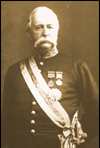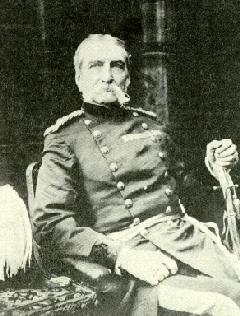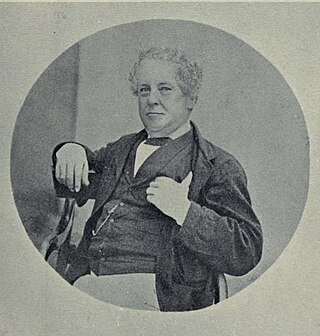
The Straits Settlements were a group of British territories located in Southeast Asia. Originally established in 1826 as part of the territories controlled by the British East India Company, the Straits Settlements came under British Raj control in 1858 and then under direct British control as a Crown colony on 1 April 1867. In 1946, following the end of the Second World War and the Japanese occupation, the colony was dissolved as part of Britain's reorganisation of its Southeast Asian dependencies in the area.

Coolie is a pejorative term used for low-wage labourers, typically of South Asian or East Asian descent.

Sir Harry St. George Ord was a British colonial administrator who served as Governor of Bermuda between 1861 and 1864, Governor of the Straits Settlements between 1867 and 1873, and Governor of Western Australia between 1877 and 1880.

Chinese Singaporeans are Singaporeans of Chinese descent. Chinese Singaporeans constitute 75.9% of the Singaporean citizen population according to the official census, making them the largest ethnic group in Singapore.

William Alexander Pickering was the first Protector appointed on 3 May 1877 by the British government to administer the Chinese Protectorate in colonial Singapore. He was the first European official in Singapore who could speak fluent Mandarin and Hokkien and gained the trust of many of the Singapore Chinese. His efforts went a long way towards controlling the problems posed by the secret societies then. Pickering Street in Singapore's Chinatown is named after him.
Secret societies in Singapore have been largely eradicated as a security issue in the city-state. However many smaller groups remain today which attempt to mimic societies of the past. The membership of these societies is largely adolescent.

The term "British Malaya" loosely describes a set of states on the Malay Peninsula and the island of Singapore that were brought under British hegemony or control between the late 18th and the mid-20th century. Unlike the term "British India", which excludes the Indian princely states, British Malaya is often used to refer to the Federated and the Unfederated Malay States, which were British protectorates with their own local rulers, as well as the Straits Settlements, which were under the sovereignty and direct rule of the British Crown, after a period of control by the East India Company.

Lieutenant General Sir Andrew Clarke, was a British soldier and governor, as well as a surveyor and politician in Australia.

Hindu religion and culture in Singapore can be traced to the 7th century AD, when Temasek was a trading post of Hindu-Buddhist Srivijaya empire. A millennium later, a wave of immigrants from southern India were brought to Singapore, mostly as coolies and indentured labourers by the British East India Company and colonial British Empire. As with Malay peninsula, the British administration sought to stabilise a reliable labour force in its regional plantation and trading activities; it encouraged Hindus to bring family through the kangani system of migration, settle, build temples and segregated it into a community that later became Little India.

Kapitan China Chung Keng Quee was the founder and administrator of modern Taiping in Perak, Malaysia. Appointed "Capitan China" by the British in 1877, he was a millionaire philanthropist and known as an innovator in the mining of tin. He was involved in many other industries including farming, pawnbroking and logging. He was respected by both Chinese and European communities in the early colonial settlement. His survival in the chaotic era owes much to his standing as leader of the Hai San, a Chinese secret society in British Malaya during the time of the Larut Wars (1862–73). a position he is said to have held till early 1884 although in all probability he continued to remain a leading member. The old fort at Teluk Batu was built by him to safeguard the mine that he opened there. He was a member of the Commission for the Pacification of Larut and sat as one of six members of the Advisory Perak State Council appointed by the British. Commenting on the role of the Perak Council, Richard James Wilkinson wrote,
"It is for the reader, in the light of subsequent events, to judge how far the Councillors were right or wrong, and to see for himself who really did the pioneer work of building up the prosperity of Perak. In the published accounts of British rule in Malaya, sufficient prominence has not always been given to the efforts of these early pioneers; the reaper, intent on his own work, is apt to forget the man who sowed. These Council Minutes are the record of the work of the sowers. A study of that record will show how much the State owes to Sir Hugh Low and to his fellow-Councillors, especially Raja Dris, Sir William Maxwell, and the Chinese towkays, Ah Kwi [Chung Keng Quee] and Ah Yam."

The history of the modern state of Singapore dates back to its founding in the early 19th century; however, evidence suggests that a significant trading settlement existed on the island in the 14th century. The last ruler of the Kingdom of Singapura, Parameswara, was expelled by the Majapahit or the Siamese before he founded Malacca. Singapore then came under the Malacca Sultanate and subsequently the Johor Sultanate. In 1819, British statesman Stamford Raffles negotiated a treaty whereby Johor will allow the British to locate a trading port on the island, ultimately leading to the establishment of the Crown colony of Singapore in 1867. Important reasons for the rise of Singapore were its nodal position at the tip of the Malay Peninsula flanked by the Pacific and Indian Oceans, the presence of a natural sheltered harbour, as well as its status as a free port.

Singapore in the Straits Settlements refers to a period in the history of Singapore between 1826 and 1942, during which Singapore was part of the Straits Settlements together with Penang and Malacca. Singapore was the capital and the seat of government of the Straits Settlement after it was moved from George Town in 1832.

The Old Ministry of Labour Building is a former building of the Ministry of Labour located at Havelock Square in the Outram Planning Area, within the Central Area of Singapore's central business district. The building once housed the former Chinese Protectorate which was first established in 1877 to protect and control Chinese immigrants to Singapore. The building had since been restored in 1990 and currently used as the Family and Juvenile Court of Singapore.

Thomas Dunman (1814-1887) was an Englishman during the British Colonial period. He arrived in the Straits Settlements and the Crown Colony of Singapore from England. Dunman was the first Commissioner of Police in Singapore, Straits Settlements from 1856 to 1871.

The Kangchu system was a socio-economic system of organisation and administration developed by Chinese agricultural settlers in Johor during the 19th century. The settlers organised themselves into informal associations, and chose a leader from among themselves.

Khoo Thean Teik was one of the most powerful and notorious Hokkien leaders of 19th-century Penang. His name, "Thean Teik", means "Heavenly Virtue". He was the leader of the Tokong or Khian Teik society that was involved in the Penang Riots of 1867 and through its connection with the Hai San, the internecine Larut Wars of 1861 to 1874. He traded through the companies Khoon Ho and Chin Bee. He was a towkay, trading in immigrant labour and had interests in the Opium Farms in Penang and Hong Kong. Thean Teik Estate, a residential neighbourhood in Penang, and Jalan Thean Teik are named after him.

The first phase of European colonisation of Southeast Asia took place throughout the 16th and 17th centuries. They wanted to gain monopoly over the spice trade as this trade was very valuable to the Europeans due to high demand for various spices such as pepper, cinnamon, nutmeg, and cloves. This demand led to the arrival of Portuguese, Spanish, Dutch, and later French and British marine spice traders. Fiercely competitive, the Europeans soon sought to eliminate each other by forcibly taking control of the production centres, trade hubs and vital strategic locations, beginning with the Portuguese acquisition of Malacca in 1511. Throughout the 17th and 18th centuries, conquests focused on ports along the maritime routes, that provided a secure passage of maritime trade. It also allowed foreign rulers to levy taxes and control prices of the highly desired Southeast Asian commodities. By the 19th century, all of Southeast Asia had been forced into the various spheres of influence of European global players except Siam, which had served as a convenient buffer state and sandwiched between British Burma and French Indochina. The kings of Siam had to contend with repeated humiliations, accept unequal treaties among massive French and British political interference and territorial losses after the Franco-Siamese War in 1893 and the Anglo-Siamese Treaty of 1909.
The coming of the British to Singapore and the subsequent establishment of British rule saw the rise of secret societies in this small colony. Whilst known as "secret" societies, paradoxically they often worked in the open, and even played essential and functional roles within society, with state knowledge or tacit cooperation.

Opium was first recorded in Singapore by a written document that record Stamford Raffles gifting opium to a local ruler in 1819 to establish Singapore. Opium then became accessible through trading and the opium farms in Singapore in the 19th century. It is one of the most traded good along the Sea Trade route after the end of the Opium Wars. With the rise of opium farms in Singapore, they acted as the middleman that help to process raw opium imported from British India, Persia, and Turkey to consumable opium and retail them to the Chinese coolies in local. In 1946, opium, including the tools, and opium dens are completely banned in Singapore. To treat the opium addicts, an Opium Treatment Centre was opened in 1955 and in 1989, the Singapore government extends the death penalty for opium traffickers.















